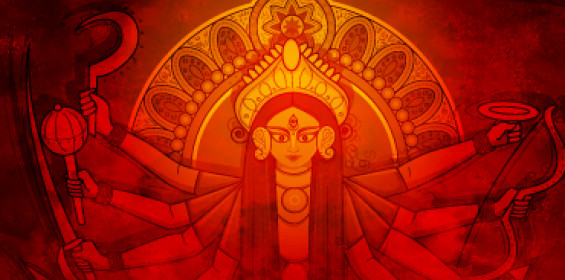What would you think of someone who was born in a jail, raised in a rural setting, and trained to be a cowherd? While you ponder that, what if you learned that this person became the most trusted friend, counsel, and strategic consultant of kings, not to mention his words form the substance of the timeless and inspirational guide on living a good and righteous life – the Bhagavad Gita! Yes, we are talking about Lord Krishna, the omnipotent and omniscient manifestation of the Divine.
With Krishna Janmashtami just around the corner, let’s find out more about this special day. Why do we celebrate it and how?
1. What is Krishna Janmashtami and why is it celebrated?
Krishna Janmashtami is the day Krishna was born. It is also called Gokulashtami, because Krishna, the eighth avatar of Lord Vishnu, was born in Gokul on the eighth (Ashtami) day. Lord Krishna took birth to spread the message of dharma, love, and oneness on earth. Therein lies the importance of Janmashtami to the people of India and around the world.
That is why there are grand festivities and joyful celebrations during Krishna Jayanthi all across India, especially in Mathura and Vrindavan (in modern-day Uttar Pradesh, India), where Lord Krishna was born and grew up.
2. Is Krishna Janmashtami the same as Krishna Jayanthi?
Yes, it is. Krishna’s birth is called Sri Jayanthi, which is a star configuration.
Indian astronomers have accorded special names to lunar phases occurring at certain stars. The phase of the moon occurring at Rohini star is called Jayanthi. As the moon was at Rohini star during Lord Krishna’s birth, his birthday is called Sri Jayanthi.
Jayanthi also means ‘celebrations’, which is the perfect word for describing the mood during Janmashtami.
3. Tell me the story of Janmashtami.
At the time of Lord Krishna’s birth, his mother Devaki and father Vasudeva were imprisoned by his power-hungry uncle, who was the king of Mathura, Kamsa. He did this because it was foretold that Devaki’s child would be his nemesis. Hearing this, Kamsa planned to kill Devaki but Vasudeva pleaded for her life and promised to hand over all their children to him. This is how Kamsa killed six of their children. The seventh one, Balarama, was transferred to another of Vasudeva’s wife, Rohini’s womb, through divine intervention. Hence, the seventh child was saved.

Lord Krishna was the eighth-born son. He was born at midnight in the midst of a thunderstorm. It is said that as divinity had taken birth, a number of miraculous things happened simultaneously: the chains on Vasudeva’s hands broke, freeing him; the palace guards fell into a stupor-like sleep; the gates of the prison fell open, and even the Yamuna River, in spate, parted to offer Vasudeva safe passage to transport the baby away from harm’s way. He took the infant Krishna to Gokul, where he exchanged him with that of his friend, Nanda’s baby girl. He felt sure that even merciless Kamsa would not harm a girl, and so both children would be spared.
The parting of the Yamuna was a natural and scientific phenomenon!
There is an interesting explanation for the seemingly miraculous parting of River Yamuna in a theory called the wind setdown theory as published by Bharath Gyan, a research body.
This theory states that in coastal areas, where there are shallow waters, (the Yamuna was a much smaller river in those days) strong winds, acting continuously on a body of water, can push the waters away from the shore. Undulating ridges under the body of water can temporarily contain the receding waters. This is possibly how a small, dry stretch of land was created for a short period of time.
It is a rare phenomenon but it does explain how the Yamuna river parted for Vasudeva allowing him to cross it with infant Krishna in a basket.
4. Did Kamsa not find out about this switch?
When Vasudeva took the baby girl back to the prison with him, Kamsa immediately attempted to kill her, but he was warned that the child that would one day bring about his downfall was still alive. So, Kamsa set about to find Krishna. Meanwhile, Kamsa tried to safeguard himself in various ways, including killing all the children that were born on that very night.
5. How did Lord Krishna, a simple cowherd from Gokul, kill Kamsa, the powerful king of Mathura?
Lord Krishna was born with divine powers. Even as a child, he escaped the treacherous clutches of Putana, the infant-killer, who had been sent by Kamsa to kill all the babies born in that Shravana month. Similarly, he managed to kill all the asuras (divine spirited forces who were opposed to the Devas, Gods) sent by Kamsa.

After this, he set out to Mathura and defeated and killed the tyrannical king, Kamsa. This is how he saved the people from the ruthless rule of the king.
Krishna saved many people from harassment and oppression. Here is a video of how he saved 16,000 women!
Watch how Lord Krishna saved 16,000 trapped women from another oppressor, Narakasur
6. What is the deeper meaning of Janmashtami?
There is an interesting interpretation of the story of Janmashtami, which gives us a peep into its deeper meaning.
Lord Krishna’s mother, Devaki represents the body, while his father represents prana (life force). Lord Krishna symbolizes love. His uncle, Kamsa stands for ego. When the ego takes over, it attempts to destroy love. The body feels imprisoned and life feels worthless.
However, love has the power to overcome the ego. When Krishna (love) is born, the guards fall asleep. Here, the guards symbolize our senses. When the senses are in the midst of love, they turn inwards and this leads to real and pure joy.
If you enjoyed this delightful interpretation of the deeper meaning of Janmashtami by Gurudev Sri Sri Ravi Shankar, you can read more here.
Significance of the number ‘8’ in Lord Krishna’s life
- Lord Krishna was born on the eighth day (Ashtami) of the Krishna Paksha (the eighth phase of the waning moon).
- He was the eighth child of Devaki and Vasudeva.
- He was the eighth avatar of the preserver, Lord Vishnu.
- The number 8 has no beginning and no end which stands for the mystical nature of Lord Krishna.
- When you turn the number 8, 90 degrees to its side, it becomes the symbol of infinity (∞). Krishna is the personification of the Divine, which stands for infinite love, joy, and wisdom. A sign of unending and unbounded happiness!

From any angle, there is a totality in Krishna’s personality. This indicates that your innermost has these qualities just like a ray of sun has all the colors.
Gurudev Sri Sri Ravi Shankar
7. How do people celebrate Janmashtami?
People pray, chant, sing devotional songs, and feast!
- There are floral decorations in temples dedicated to Lord Krishna such as ISKCON in Karnataka and Jagannath temple in Odisha; idols of the lord are bathed, clothed, and decked with jewels.
- Processions are taken in chariots during Janmashtami to spread the message of dharma and unity all around.
- Group dances and songs are common; also, skits are enacted, portraying Lord Krishna’s eventful birth, childhood, victories over asuras, and the famous Bhagavad Gita recitation to Prince Arjuna during the Mahabharata war. Also, Rasa Lila takes place, where the theme is Krishna’s love for Radha and the other gopikas (cowherd girls; these) are enacted in the form of folk dances.
- Mothers dress their little ones as Lord Krishna; you will see toddlers with Lord Krishna’s signature crown and peacock feather.
- Varieties of food are prepared and relished on this special day.
- Perhaps the most popular tradition of all is the breaking of the Dahi Handi that celebrates Lord Krishna’s vivaciousness, mischievousness, and playfulness. This custom tests the agility, teamwork, and balancing powers of youth as they form pyramids to try to break the Handi!

Dahi Handi
In his childhood, butter-loving Krishna used to steal pots of milk and curd from the neighboring houses. To safeguard their pots, the women of the household used to hang it near the ceiling to keep it out of his reach. This is when Krishna and his friends came up with the idea of forming human pyramids to break the pots and eat the dairy products!
This tale has inspired many youth to fondly reenact this antic to give wings to their innate playfulness and joyfulness.
This joyful festival is predominantly a children’s festival as the stories of Krishna’s mischievous exploits as a child are the most popular and beloved of all tales.
8. Is there a tradition of fasting on Janmashtami?
Rather than fasting, Lord Krishna is all about feasting! In fact, there are 56 types of dishes that are made - Chhapan Bhog - on this day! In Puri Jagannath temple, Odisha, 56 varieties of sweets and foods are offered to Lord Krishna, Balarama, and Subhadra. ‘Bhog’ means ‘wholehearted offering of food’ to the Lord.
Keeping in mind, Krishna’s early exposure to cows and dairy products, some of the offerings are butter, pedas (sweets made of milk), panjiri (sweets made of dry fruits), kheer (sweet pudding), and fried snacks like sabudana vada (fried snacks made of sago), sweet and salty seedai and thattai (snack items made of Bengal gram flour and rice).
After eating all the rich delicacies of this special day, it is a good idea to eat a ginger-jaggery powder, as it will aid in digestion. Jaggery khandsari is a delicacy of this time.
Some people do fast but it is a personal choice rather than an established tradition. On Janmashtami, these devotees undertake fasts consisting of seasonal fruits and water only. They break their fast after midnight that day, when the Lord was born.
9. When is Krishna Janmashtami in 2020?
It falls on Aug 11th this year.
10. Was this really the day Lord Krishna was born?
Yes - according to the Indian regional calendar.
According to the Bhagavata Purana, Lord Krishna was born at midnight in the month of Shravana, on the eighth phase of the moon, Ashtami Tithi. The moon was near Vrshabha - the Taurus constellation - that houses the star Rohini.
This date in his year of birth, 3112 BCE, was actually July 27 according to the Gregorian calendar. But, since we celebrate Krishna Janmashtami according to the regional calendar, this date varies every year in the Gregorian calendars that we refer to today. If you would like to know more about the astronomical aspects of Krishna’s birth, read here.
Janmashtami is a joyful time when we have a chance to celebrate and experience the presence of Krishna in our lives. Explore, experience, and enjoy this special day to the fullest!
Click here for the webcast of Janmashtami celebrations at the Art of Living Ashram.
Now that you have read about the joyful celebrations of Janmashtami, you might like to experience some inner celebration as well. Join the Online Meditation and Breath workshop here to feel the abundance, and joy around you this Janmashtami!
Based on inputs from articles written by Dr. D K Hari and Dr. D K Hema Hari, authors and founders, Bharath Gyan. For more information on India, you can follow the founders of Bharath Gyan on Twitter @bharathgyan
We’d love to hear from you. Leave your comments @artofliving



































